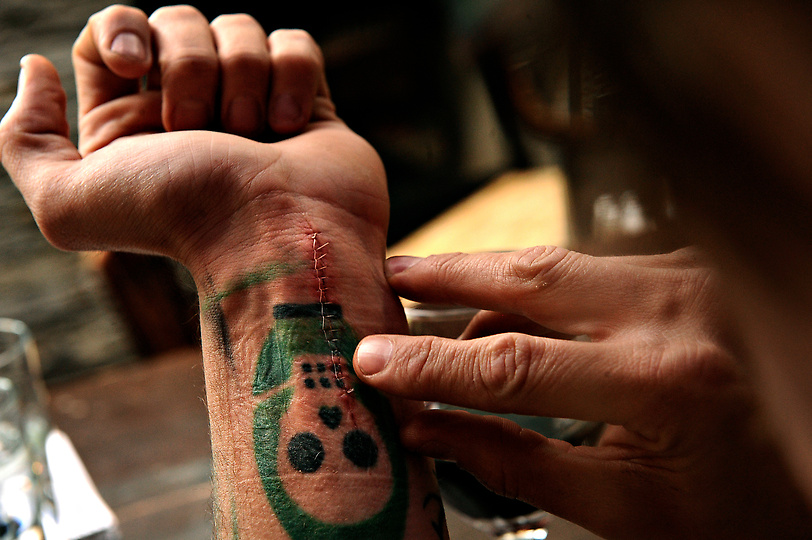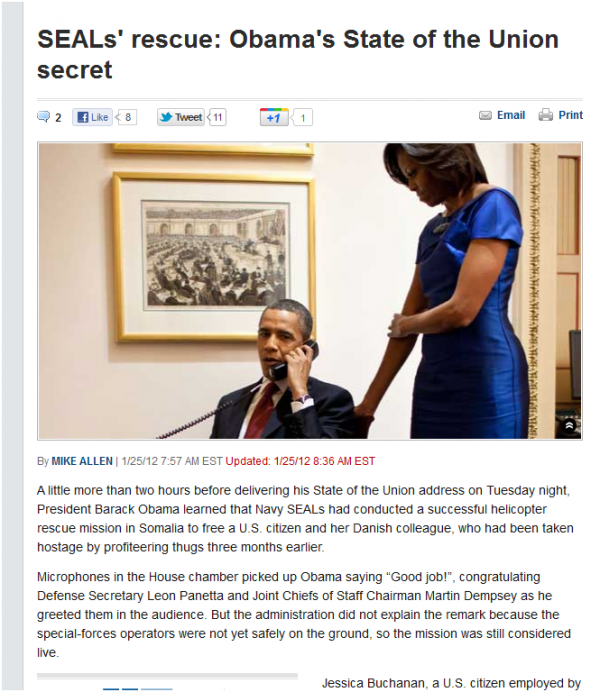Notes
Perhaps It’s a Wonder Vet Suicide Rate as Low as It Is

Scott counts the stitches in his wrist while having a drink at a bar in Boulder after his suicide attempt. Scott said many times he should have died overseas, and during the fight with his girlfriend, she agreed. “I just grabbed a pair of scissors. … I just tried jabbing them into my neck, but they were closed, so I just gave myself a nice laceration. So, I grabbed a nice kitchen knife and cut my wrists,” Scott said.
The VA reports that 18 veterans commit suicide every day. And last week the U.S. Army reported that the suicide rate among active duty soldiers has risen from 9.6 per 100,000 in 2005 to 24.1 per 100,000 in 2011. The number of attempted suicides is astronomically higher still and all out of proportion with the suicide rate among the civilian population. Reports of all of this leak out from time to time, of course, but the tendency is to make the problem abstract by focusing on the aggregate and not so much on the individuals. The numbers underscore the sheer magnitude of the problem, but at the same time they make it almost impossible to imagine the individual trauma … or perhaps the better word here would be “envision.” And because the real effects of the problem are harder to see in the abstract, they are also easier to be blind to. We are not inclined to quote totalitarians in the affirmative here at NCN, but Josef Stalin’s characterization of such situations is much to the point, “[o]ne death is a tragedy, one million deaths is a statistic.” The situation is thus really something of a catastrophe: a problem that we don’t appear to know how to solve (assuming we exclude the obvious and refuse to eliminate the root cause, which is sending our young men and women to fight of such wars in the first place) and yet one that is so large and so present that the logic of its representation encourages us to acknowledge and ignore it simultaneously.
A large part of the difficulty is that it is virtually impossible to get photographs of actual suicides and one would surely have to challenge the ethics of taking such photographs if one could do so. And yet it is not sufficient to turn a blind eye to the situation. A slideshow at the Denver Post titled “Welcome Home” is much to the point in this regard as it invites us to see into the life and mind of at least one contemporary war veteran and his struggles with readjusting to the civilian world. Part of the story conveyed by the slideshow is the all too conventional tale that the veteran’s return home is experienced as altogether lonely and alienating, and in any case anything but welcoming. No less true for being conventional, the photograph above signals a second, more poignant and even more troubling story as well. Tattooed with what appears to be the face of death—a marking which it will turn out is probably not incidental—the wrist belongs to Brian Scott Ostrom, an honorably discharged veteran of the U.S. Marine Corp’s Second Reconnaissance Battalion who served two tours of duty in Iraq. Ostrom did not commit suicide, but as the fresh stitches that mark his wrist indicate, he made a serious attempt at doing so. In fact, it was his second such attempt. The question, of course, is why?
Like so many veterans of Iraq and Afghanistan, Ostrom suffers from PTSD, a psychological disorder that manifests itself in panic attacks and fits of rage that often lead to physical violence. Frequently that violence is directed outwards at other people or physical objects, but just as often it is directed inward at an intractable guilt that simply never goes away—and, of course, that cannot be seen. Part of that guilt is a result of having voluntarily participated in a troglodyte world in which all empathy for the other is evacuated, a world in which there is no difference between doing’s one’s job and behaving in the most brutal ways imaginable … and yet, in Ostrom’s own words, not feeling bad for “anything I did over there,” but “for what I didn’t do.”
The words are as cryptic as is the face of death on Ostrom’s wrist. But both take on an eerie and troubling significance when we recall something he said earlier in his narrative, reflecting on his PTSD, “I think it comes from the fact that I survived. That wasn’t my plan. It’s an honor to die for your country, but I made it home.” And then this, “Every one of us has a suicide plan. We all know how to kill, and we all have a plan to kill ourselves.” What he didn’t do was to die for his country. The words are as hard to hear as the photograph above is to look at.
But look at it we must, for in its own way it illustrates the problem faced by our returning war veterans writ large—a point emphasized by the fact that the hand itself is disembodied; it could belong to Ostrom (as it does) but it could belong to any of the thousands of returning veterans (or for that matter to those who might be inducted to fight in future wars): Bred to kill and marked by death, our warriors are assimilated into a topsy-turvy world in which survival is a sign of failure, and doing one’s job well results in dishonor. And there does not seem to be any way out except for one. Perhaps the only wonder is that the suicide rate amongst our veterans is as low as it is.
–John Lucaites
See Denver Post slideshow: “Welcome Home.” Photo: Craig F. Walker/Denver Post.
Cross-posted from No Caption Needed


Reactions
Comments Powered by Disqus